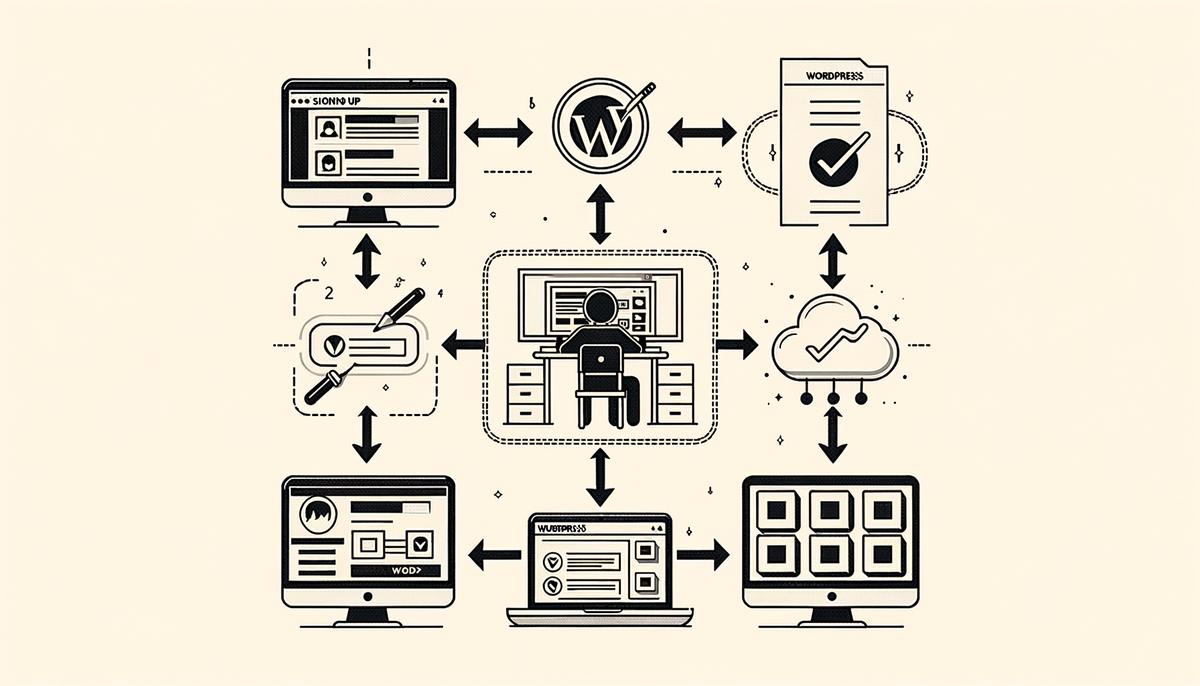Overview of Ezoic and PropellerAds
Ezoic is a header bidding partner popular among smaller publishers, especially those earning below $10 daily. With no traffic threshold for its starter package, it is accessible to many. Ezoic assists with initial ad setup, offers tech support, and provides a self-serve platform for tweaking ad formats. There's also a WordPress plugin for quick setup. One drawback is the reliance on DNS, which can slow page loads. Some publishers find the ad layouts too aggressive and leave as they grow.
Ezoic can outperform AdSense in earnings for small sites with traffic from Tier 1 regions. It doesn't favor eCommerce-centric sites. Typically, Ezoic's entry-level package attracts nascent webmasters wanting easy ad management.
PropellerAds is a significant alternative ad network, featuring 32,000 advertisers. It specializes in high CPM formats, including interstitial ads, push notifications, and in-page push ads. With no traffic minimum, it is an option for smaller sites needing strong returns. High viewability and CTR from aggressive formats often result in higher earnings than AdSense.
PropellerAds offers customizable templates and AI-driven ad optimization, appealing to media buyers and marketers seeking personalized ad solutions. However, domain approval can be a challenge, potentially slowing campaign starts. Optimizing campaigns for newcomers to pop or push traffic can also be difficult.
Ezoic is suited for publishers prioritizing ease and support, while PropellerAds targets those chasing higher, albeit potentially disruptive, ad revenues. Choosing between them depends on factors such as setup simplicity, ad aggressiveness, page load times, and overall revenue potential.

Performance and Monetization
Ezoic often offers more stability for small publishers in Tier 1 regions. The platform utilizes machine learning to optimize ad placements, which can enhance CPM by focusing on user experience improvements and page engagement. Typical CPM rates for Ezoic users can range from a few dollars to over $20, contingent on niche, audience, and content quality. Publishers who follow best practices in ad placement tend to see better RPM numbers.
In comparison, PropellerAds generates revenue primarily through high-impact ad formats like interstitial ads and push notifications, which are known for their impressive CTRs. These formats inherently attract more clicks due to their aggressive presentation, leading to higher CPM rates. For instance, popunder ads can yield CPM rates that surpass those of traditional display ads significantly.
However, the aggressive nature of PropellerAds' formats often carries the trade-off of potentially alienating users, impacting long-term visitor loyalty. Ads like interstitials can disrupt user experience, leading to higher bounce rates if not implemented judiciously. In contrast, Ezoic's less intrusive ad formats aim to balance monetization and user experience, striving to minimize any negative impact on SEO or page load times.
Many small publishers utilizing Ezoic appreciate the tech support and the optimization features that help maximize their revenues progressively. Conversely, PropellerAds appeals particularly to those looking for more immediate, higher returns with its high-impact ads. However, user feedback highlights the necessity for proper optimization and understanding of the ad formats to avoid any pitfalls, such as site slowdowns or reduced ad quality.
Ezoic tends to be an optimal choice for publishers prioritizing stable, long-term revenue growth with technical support and user-friendly ad management. PropellerAds suits those seeking higher short-term returns through aggressive ad formats, provided they manage potential drawbacks on user retention and site performance.
User Experience and Ad Quality
User experience (UX) and ad quality are crucial aspects to consider when choosing between Ezoic and PropellerAds. Both platforms impact page load times, site speed, and user engagement differently.
For Ezoic, the integration through DNS can sometimes result in slower page load times. While this might initially seem like a drawback, Ezoic employs various optimization techniques to mitigate these effects. Their machine learning-driven platform aims to enhance load speeds by dynamically optimizing ad placements and reducing latency. By focusing on user engagement improvements alongside revenue maximization, Ezoic strives to maintain a balance.
PropellerAds, conversely, leverages aggressive ad formats like interstitials and push notifications, which can notably affect user experience and site performance. These ads, while boosting CPM and CTR, also come with the risk of increasing bounce rates due to their disruptive nature. Popunder ads, for instance, load behind the current browser window, potentially slowing the user's browsing experience on already resource-intensive pages. This can be particularly intrusive for users, leading to dissatisfaction and potentially lower retention rates.
In terms of ad quality, PropellerAds' flexibility and extensive network of advertisers mean a varied range of ads, some of which might be less relevant or lower in quality compared to AdSense. This can detract from the site's perceived professionalism by visitors. Additionally, the aggressive placements of push notifications can sometimes border on invasive.
Ezoic, while perceived by some as having overly aggressive setups, typically aims for a more measured approach. Their platform allows for significant customization in ad placement, enabling publishers to choose less intrusive formats.
The trade-offs in ad quality and UX between the two platforms hinge on the level of intrusion acceptable to the publisher's audience. Ezoic offers stability and flexibility but requires careful management to avoid slow page loads. PropellerAds provides higher earning potential with its aggressive formats but at the expense of potentially compromising the user experience and ad quality.

Ease of Setup and Use
Ezoic is fairly accessible for beginners, particularly due to its lack of traffic requirements for the entry-level package. The platform stands out with its hands-on technical support. When you first join Ezoic, their team assists with the initial ad setup, ensuring that even those with minimal technical know-how can get started effectively. The Ezoic system integrates with your DNS, a step that might sound complex but is explained thoroughly in their setup guides and bolstered by the support team. Additionally, Ezoic provides a WordPress plugin, simplifying the integration further for those using this popular CMS.
The self-serve platform Ezoic offers is another highlight, allowing publishers to tweak ad formats and placements to suit their site's aesthetics and functionality. This flexibility is advantageous, especially when balancing monetization with user experience. However, the DNS-based integration can introduce complexity over time. More seasoned webmasters might find themselves handling occasional technical hiccups, such as DNS issues or slower initial page load times.
PropellerAds, on the other hand, emphasizes flexibility and ease of use with no traffic minimum, making it an attractive option for newcomers. The platform's initial setup requires domain approval, which can slow the onboarding process. This step ensures that the quality of the site aligns with PropellerAds' network standards.
Once approved, PropellerAds provides a myriad of high-impact ad formats like push notifications, interstitials, and in-page push ads. The platform offers customizable templates and AI-driven optimization, which can streamline the creation of effective ad campaigns. User-friendly dashboards and real-time analytics enable publishers to monitor and refine their ad performance closely. However, for those unfamiliar with pop or push traffic, there could be an initial learning curve. Properly leveraging these ad formats necessitates a degree of understanding to avoid disruptions to user experience.
Ezoic's setup process is bolstered by comprehensive technical support and beginner-friendly tools, making it an excellent choice for novice publishers with no minimum traffic prerequisite. PropellerAds, while demanding domain approval, offers flexible, high-impact ad formats and AI tools that require a bit more time to master but can potentially yield higher immediate returns.

Suitability for Different Types of Blogs
Ezoic and PropellerAds have distinct strengths making each more suitable for different types of blogs and niches.
For small publishers, Ezoic tends to be highly suitable, especially those just starting out. Its lack of traffic requirements for the introductory package allows new bloggers to begin monetizing their content without the pressure of reaching specific visitor counts. The included tech support and easy setup via the WordPress plugin are particularly beneficial for those with limited technical expertise. By leveraging Ezoic's machine learning and optimization features, small publishers can gradually improve their ad revenue while getting to grips with ad management fundamentals.
On the other hand, PropellerAds is also welcoming to small publishers with its no minimum traffic requirements. However, its more aggressive ad formats such as push notifications and interstitials might not always align well with the modest traffic and needs of a nascent blog. While these formats can yield higher CPM rates, they can also lead to higher bounce rates, which could be counterproductive for small sites looking to build a loyal audience base.
Tech blogs often benefit from Ezoic's machine learning algorithms that focus on improving user engagement. As tech audiences typically expect fast load times and minimal disruption, Ezoic's approach to balancing ad revenue with user experience can be advantageous. The ability to customize ad placements and formats ensures that content quality and page load speed are not compromised, thereby maintaining the satisfaction of a tech-savvy audience.
PropellerAds can also be effective for tech blogs, particularly those willing to experiment with high-CPM formats like interstitials and push notifications. These aggressive formats can capture the attention of a tech audience, driving higher click-through rates. Yet, it's crucial for tech bloggers to balance these high-impact ads with user experience to prevent alienating their reader base.
Ezoic typically doesn't cater to predominantly eCommerce-focused websites. The initial DNS integration could complicate time-sensitive eCommerce operations, and the aggressive ad setups might detract from the user experience needed to drive sales.
Conversely, PropellerAds might offer more synergy for eCommerce sites due to its high-CTR ad formats that can effectively promote products and offers. Push notifications, for instance, can be used to alert customers about special deals or new arrivals, driving immediate traffic and potential sales. However, it's essential for eCommerce sites to ensure that these ads don't oversaturate the user experience.
Blogs within niche categories—such as lifestyle, travel, and education—can also find distinct benefits from each platform. Lifestyle and travel blogs, for instance, might appreciate Ezoic's focus on user experience and engagement. Improved ad placements and supportive tech features ensure monetization without compromising the aesthetic and navigability of visually-driven content, which is often key for these niches.
In contrast, PropellerAds' diverse ad formats might appeal more to niche blogs focusing on fast-paced content and immediate user actions. Education blogs, for instance, could effectively use in-page push ads to engage readers with additional resources or course sign-ups directly through the content. The high-viewability formats could be particularly potent in niches requiring focused reader interaction.
The suitability of Ezoic versus PropellerAds varies significantly depending on your blog's niche and objectives. Ezoic favors stability, technical support, and gradual revenue growth, making it a solid choice for small, tech, and visually-driven niche blogs. PropellerAds offers higher immediate returns through aggressive ad formats, which can be particularly beneficial for eCommerce sites and blogs within dynamic niches requiring high engagement levels. The choice between these platforms hinges on understanding these nuances and aligning them with your blog's individual needs and goals.
- Ezoic. Ezoic vs Adsense earnings: what is the difference? Ezoic blog. June 2021.
- PropellerAds. PropellerAds review. PropellerAds website. 2022.
- Ezoic. Everything you need to know about Ezoic site speed accelerator. Ezoic support center. 2023.
- PropellerAds. Push notifications ads: the ultimate guide. PropellerAds blog. September 2020.
- Ezoic. What is Ezoic? Ezoic website. 2023.



